Awen & Oak: The November Nature Diary
Global turmoil; navigating the mysteries instead of fearing the unknown
I traipsed through the boreal forest, following the prickly-backed porcupine that held fast to the very same foot trail us two-legged folk use everyday. He was mostly unbothered by my presence, perhaps an indication that he was used to seeing my kind on this well-loved path in Quebec’s popular Mont Orford National Park. I wondered if he still feared me, despite being covered in thousands of beautiful little defensive spikes. The occasional furtive glance backwards told me that he was at least hesitant.
It was the final week of autumn’s lush and vibrant fall foliage. My partner and I had escaped Montreal to spend some time in the forests of southeast Quebec. We walked through the natural canvas, stopping at times to admire the vibrant red of low-hanging maple leaves, the bright and rich yellows of the poplars, and the varying shades of warm tones that littered the forest floor.
Time works differently in the forest. Time is measured by the happenings of the landscape. Micro-seasons including “when the leaves turn,” followed by “when the leaves are brown,” and finally “when there are no more leaves.” Fall is as much a mental landscape as a physical one. It is a liminal time where we, and the forest, await the long months of cold and snow.
Here in North America, a lot of us find ourselves in a time of political liminality as well. I write this newsletter just as America has elected Donald Trump once more. Though I live in Canada, I know that we are all connected. When a nation with such massive political, environmental, and cultural power votes, we feel it everywhere.
In the media I see a lot of people talking about fearing the unknown in these times of liminality. What will the election results mean for women, our planet, our minorities, our reproductive rights? In Canada we face an upcoming election as well, and as the second largest geographic nation on earth, our leadership rules over a vast amount of nature. Our government’s decisions will impact future generations, for better or worse.
There is a lot of unknown right now. We stand at the precipice of multiple crises, watching the headlines each day and doomscrolling until our dreams become nightmares of nuclear threats. Maybe we are navigating the unknown in our personal lives as well. My own career as a fledgling writer, and as a film crew technician, has been in a state of flux all year. There have been days when I walked in the woods just to remind myself about nature’s time and her gentle embrace.
And then I read something wonderfully insightful yesterday. In an article of my new favourite publication, Emergence Magazine, Martin Shaw writes in their 2021 print issue Living with the Unknown, “what if we reframed “living with uncertainty” to “navigating mystery”?
And there it was.
A spark and realization: we are not living with the unknown, we are navigating a mystery.
There was always something that felt cold and dead about the idea that we lived in the unknown. Something scientific that lacked the human touch. The unknown is a mystery. But unlike the cold unknown, a mystery beckons human curiosity. It drives us to explore, engage, and act.
What if I removed unknown and replaced it with navigating the mystery? There is a sense of empowerment there, too. Living alongside the unknown becomes passive language, a concept that says we cannot know and perhaps we never will.
Navigating the mystery urges us to remember the sacredness of our human journey. There was mystery on those trails I hiked; the mystery of where the porcupine lived; the mystery of what I would find on the next viewpoint as my feet carried me up a 200-metre incline; the mystery of what I would uncover about myself and my world when all the mental chatter quieted down.
The universe is made of atoms, but people are made of stories. And so are the uncertainties. They are merely mysteries that have yet to unravel, but we play a part in that unraveling. Things fall apart, things come together. One solved mystery always leads to another, as our lives unfold and enfold, one discovery and question after another.
The forest knows this. The creatures that live amongst her trees know this. The trees do not fear elections, nor does the porcupine. But they are engaged in the same mystery as us, unaware of how our human choices will affect their air, their homes, their health.
We seek to control the unknown. We call astrologers, we divine with tarot cards, we study statistics and data. We build financial portfolios, plan for retirement, and organize our weeks in advance. It makes me wonder how much of our lives are spent in the passive “living with uncertainty” rather than the active and engaged “navigating the mysteries”.
As I move into the snowy season, my goal is to shift my headspace into one that experiences life as a series of mysteries. I want to be engaged with the world, and not through fear, but through curiosity.
How might you do the same?
Inspired by Oak: What I learned from the trees this month
Over the past few years I have developed a fondness for hugging trees. One day, on a pandemic-lockdown era walk in the forest, I felt an urge to hug a tree. Specifically, the soft and smooth trunk of a beech tree. I have often wondered since if it was a desire borne of my growing love and connection to the forest, or if there was a sentience that my mind and body were responding too.
I felt the vibration of the tree, such a subtle hint of sentience. Trees don’t hug back, but somehow they still offer comfort. My cheek brushed the smooth bark and I felt present and alive. I wondered how old that tree was; had it been here before the agricultural fields began to surround the area? Or was it new growth, popping up over the past fifty or so years?
Trees in the ancient Celtic cultures were revered as ancients. They can live for hundreds or even thousands of years. A Mi’kmaq elder who hosted me and a group of others at his sweat lodge years ago told us how stones were called grandfathers in his culture. That was because they have existed since time immemorial and they have seen everything; the rise and fall of societies, the passage of ice ages, the dinosaurs and the Iron Age.
Just like the grandfather stones, old growth trees contain geographic knowledge. They have experienced changing climates, absorbed the vibrations of people and animals wandering nearby, and have stood tall through it all.
As the election loomed and reached its harrowing finale in the selection of Donald Trump as president, I found my worries for the future tempered when I once again stood beneath these ancients.
We are living in a turbulent time and the next year is sure to bring with it many changes and difficulties. Though I live in Canada, we are still very entwined with he realities of our southern neighbours. Everything from trade deals to our relationship with both the citizens and their government can shift depending on who is in power. Right wing politics can make their way north, like an ideology that travels on grey skies and rains down toxic hatred on people who were born with none.
Times will get more contentious, abroad and at home. But the trees embrace me with their ancient wisdom: empires come, empires go; times get harder, times get easier. There will be difficult days and months, but there will also be joy. Our human story is a short one in relation to all of the living beings we share this earth with.
Societies run in cycles, as do empires. We may be witnessing an empire in decline, but as I learned from my own personal struggles in life: breakdown can also be breakthrough.
Sometimes things must become more difficult before they can get easier. But standing at the end of the long road of Western civilization will lay something new; something we are yet to see or know. It could be worse, but it could be gloriously better. The trees will stand in their trustworthy stillness.
When we fear the present moment and the near future we need only to remember: this too shall pass.
Inspired by Awen: An Art Montage from the Mountains
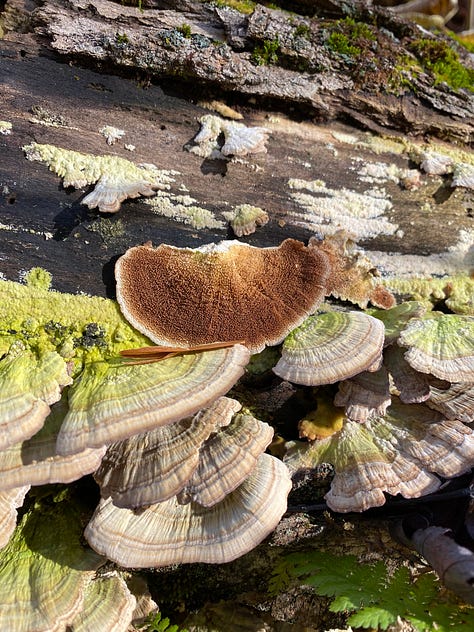
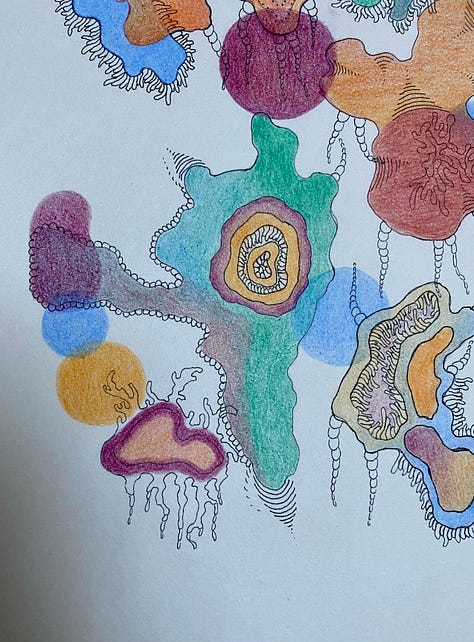
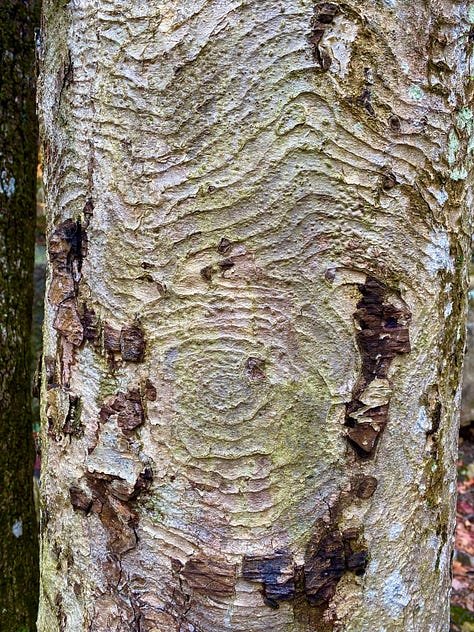
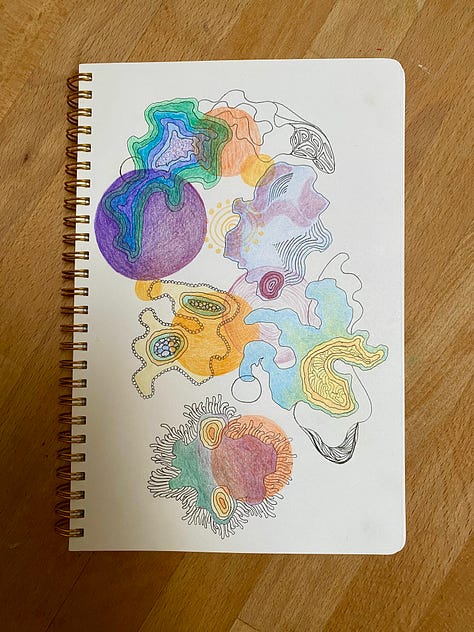
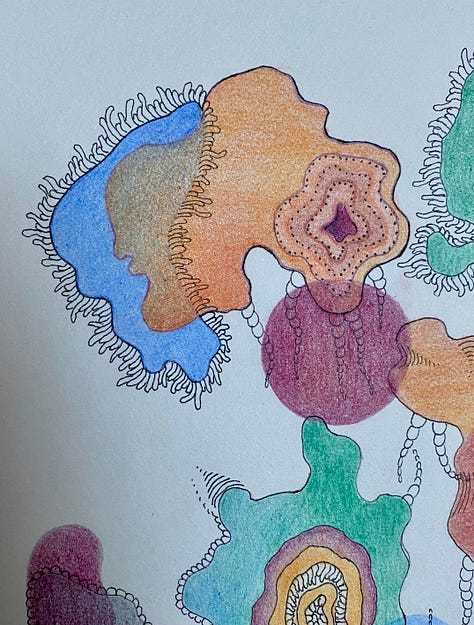
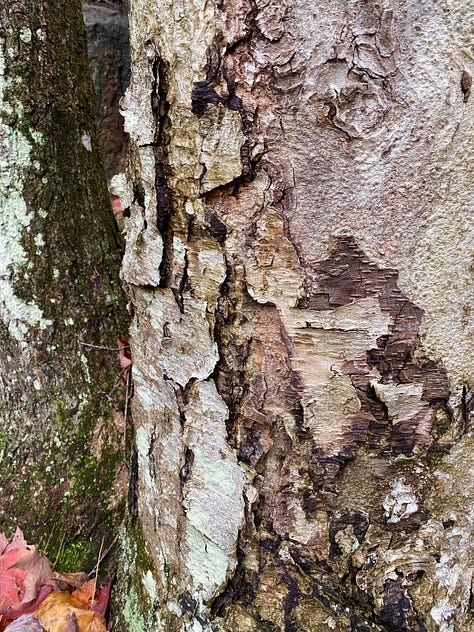

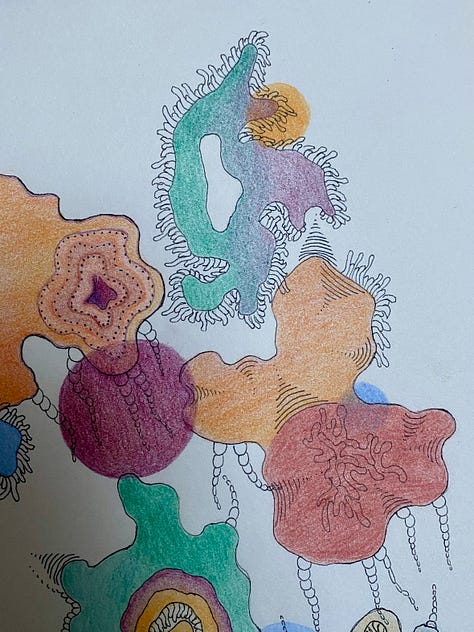
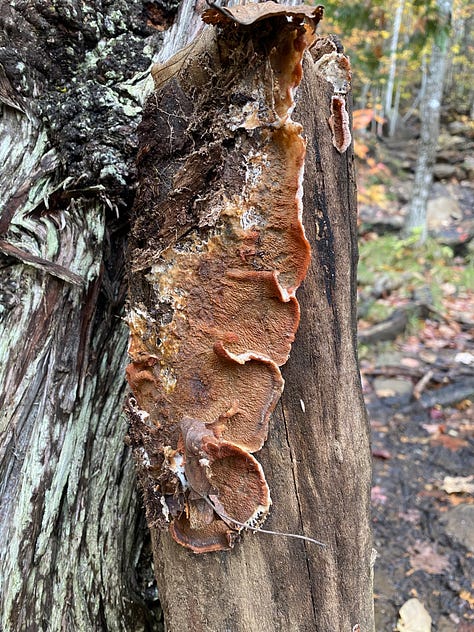
This fall I had a lot of fun taking inspiration from the shades and textures found on logs and leaves. Sometimes I like to do what I call “intuitive drawing”. I let my pen guide my hand in fluid motions as I create shapes and patterns without too much conscious thought. The result is artwork that feels organic and unique.
I like to take pictures in the woods; mushrooms, bark, leaves, upward shots of the skyline between a cluster of trees. I let these images sit in my mind until I return home and put pen to paper. Above is the result of letting my pen dictate shapes, and filling in the rest with colours and details from my imagination.
If you like this, you can follow my instagram account to see more of my art and my creative process.
Inspired by Creatives: Listening, watching, reading
Listening
Emergence Magazine Podcast: On Time, Mystery, and Kinship
This expansive conversation played while I sketched out some new art ideas on a rainy afternoon. Jane Hirshfield is a poet with a soft voice that delivers powerful messages and insights. Her reflections on deep time and our timely relationship with our world was inspired by her time spent in Zen communities over the years. I might listen again.
Watching
I only recently learned that those sweeping, grass-covered Scottish highlands used to be covered in trees. This documentary highlights not only the loss of biodiversity in Scotland, but the hope and promise of restoration. Having Scottish ancestry on both sides of my family, the homeland has always held a special place in my mind and heart.
The documentary crew travel to other places in the world to explore how they have been rewilding, and then look at how they can make it a reality in Scotland, too. Living in Canada, it begs me to ask, how can I rewild my own home?
Reading
Going to Seed by Kate J. Neville
These essays are not only informative and insightful, they are poetic. Neville’s writing is beautiful and perfect to delve into with a cup of tea. I have drawn a lot of inspiration for my own Medium stories and blog posts on work, culture, and nature from her writings.
Until Next Time…
I celebrated the Celtic new year, known in Gaelic as Samhain (pronounced sow-inn) on October 31st. The time that most of us know as Halloween is also an ancient Celtic holiday. It is a liminal time when the barrier between the human and spirit world is considered to be at its thinnest. It is also a harvest time, when we sow the last of our garden before the snow creeps in.
Some friends and I gathered for a group reading from a Druidic guidebook of the Order of Bards, Ovates and Druids. After a meditative reflection, we pulled some tarot cards to have a look at our year ahead and examine what we needed to leave in the past.
These rituals of new beginnings and closure allow us to reflect on who we are, who we have been, and who we would like to become. Just like Yom Kippur, Lent, or Ramadan, these times of reflection can be used to help us become better people, to right wrongs from our past, and to look towards the future with a vision and hope.
What can you leave behind with the falling leaves? What can you embrace with the coming snow?







